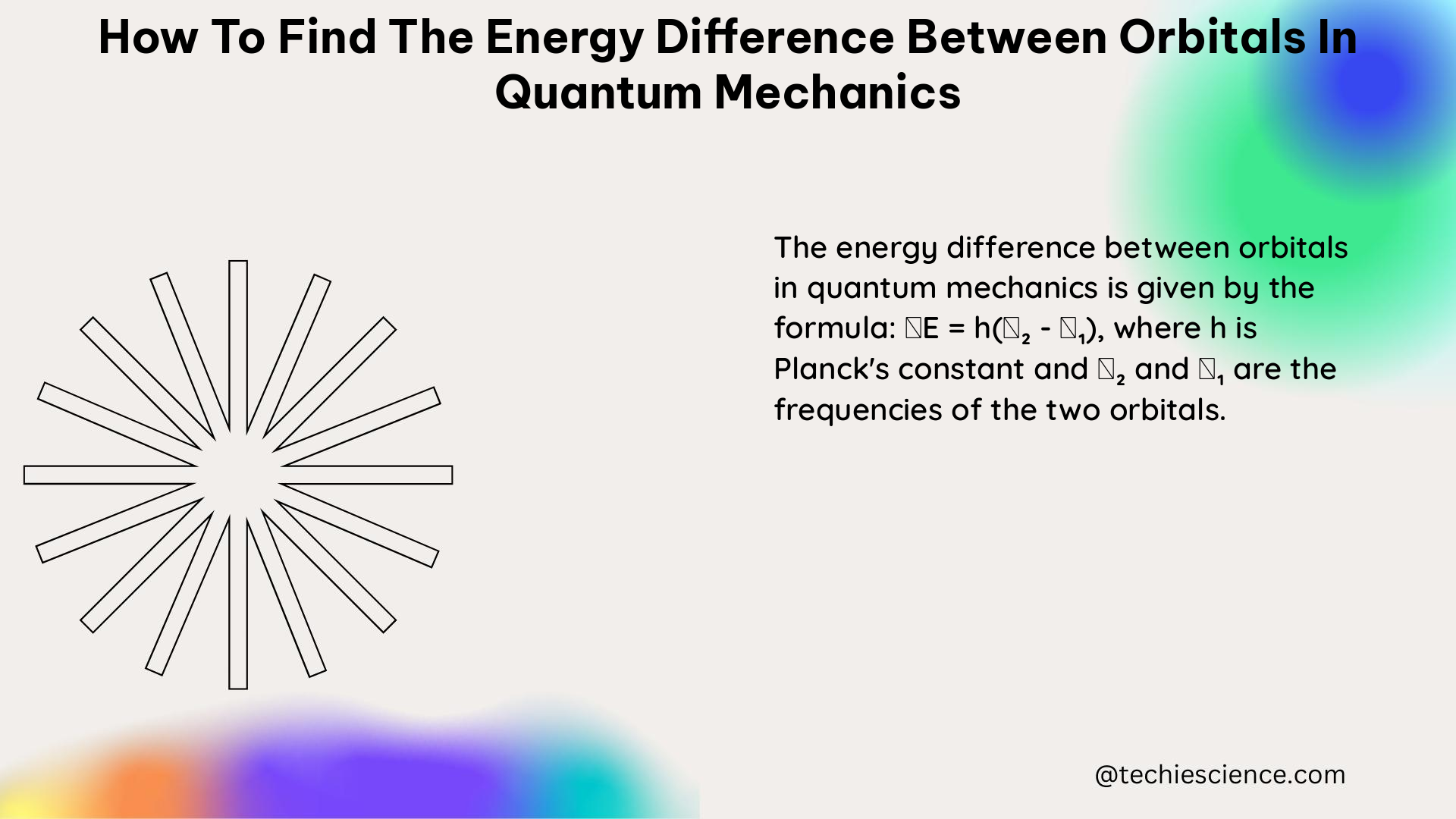In quantum mechanics, the energy difference between orbitals is a fundamental concept that has important implications for understanding the behavior of atoms and molecules. This comprehensive guide will provide you with a detailed understanding of how to calculate the energy difference between orbitals using the Rydberg formula, as well as how to determine it experimentally through spectroscopy.
Understanding Energy Levels and Orbitals
In quantum mechanics, an orbital is a mathematical function that describes the probability distribution of an electron around the nucleus of an atom. Each orbital has a specific energy level associated with it, and electrons occupy these orbitals based on the Pauli Exclusion Principle, which states that no two electrons can occupy the same orbital with the same spin.
The energy levels of an atom are quantized, meaning they can only take on certain discrete values. These energy levels are labeled using the principal quantum number, n, which can take on integer values from 1 to infinity. The energy of an electron in an atom is inversely proportional to the square of the principal quantum number, as described by the Bohr model of the atom.
Calculating the Energy Difference Using the Rydberg Formula

The energy difference between two orbitals in an atom can be calculated using the Rydberg formula, which is derived from the Bohr model of the atom. The formula is given by:
ΔE = -hcRZ^2[(1/n_f^2) – (1/n_i^2)]
where:
– ΔE is the energy difference between the two energy levels
– h is Planck’s constant (6.626 × 10^-34 J·s)
– c is the speed of light (3.00 × 10^8 m/s)
– R is the Rydberg constant (1.097 × 10^7 m^-1)
– Z is the atomic number of the atom
– n_i is the initial energy level
– n_f is the final energy level
To illustrate the use of the Rydberg formula, let’s calculate the energy difference between the 2s and 1s orbitals in a hydrogen atom (Z = 1).
The energy level of the 1s orbital is given by:
E_1s = -hcRZ^2/(1^2)
The energy level of the 2s orbital is given by:
E_2s = -hcRZ^2/(2^2)
The energy difference between the two orbitals is therefore:
ΔE = E_2s – E_1s
ΔE = -hcRZ^2/(2^2) – (-hcRZ^2/(1^2))
ΔE = hcRZ^2[(1/1^2) – (1/2^2)]
ΔE = hcR[(1/1) – (1/4)]
Substituting the values of h, c, and R, we get:
ΔE = (6.626 × 10^-34 J·s)(3.00 × 10^8 m/s)[1.097 × 10^7 m^-1][(1/1) – (1/4)]
ΔE = 1.89 × 10^-18 J
Therefore, the energy difference between the 2s and 1s orbitals in a hydrogen atom is 1.89 × 10^-18 J.
Determining the Energy Difference Experimentally
In addition to the Rydberg formula, the energy difference between orbitals can also be determined experimentally through spectroscopy, which is the study of the interaction between light and matter. By shining light on an atom or molecule, we can excite electrons from one energy level to another, and the resulting spectrum of light emitted or absorbed can be used to determine the energy difference between the orbitals.
The energy of a photon emitted or absorbed during a transition between two energy levels is given by the Planck-Einstein relation:
E = hv
where:
– E is the energy of the photon
– h is Planck’s constant
– v is the frequency of the light
By measuring the wavelength or frequency of the emitted or absorbed light, we can calculate the energy difference between the orbitals using the Planck-Einstein relation.
For example, the emission spectrum of hydrogen consists of a series of distinct lines, each corresponding to a transition between two energy levels. By analyzing the wavelengths of these lines, we can determine the energy differences between the various orbitals in the hydrogen atom.
Practical Applications and Implications
The energy difference between orbitals is a fundamental property of atoms and molecules, and it has important implications for a wide range of fields, including:
-
Chemistry: The energy differences between orbitals determine the stability and reactivity of atoms and molecules, which is crucial for understanding chemical reactions and the formation of chemical bonds.
-
Physics: The energy differences between orbitals are essential for understanding the behavior of atoms and molecules in various physical phenomena, such as atomic and molecular spectroscopy, quantum mechanics, and solid-state physics.
-
Materials Science: The energy differences between orbitals play a crucial role in the properties and behavior of materials, such as their electronic, optical, and magnetic properties, which are important for the development of new technologies.
-
Astrophysics: The energy differences between orbitals in atoms and molecules can be used to study the composition and properties of celestial bodies, such as stars and interstellar gas clouds, through the analysis of their emission and absorption spectra.
In summary, understanding how to calculate and determine the energy difference between orbitals in quantum mechanics is a fundamental skill for any student or researcher working in the fields of physics, chemistry, materials science, and astrophysics.
References
- Quantum Theory, Chemistry Department, Florida State University, https://www.chem.fsu.edu/chemlab/chm1045/quantum.html
- Quantum Mechanics and Atomic Orbitals, Chemistry LibreTexts, https://chem.libretexts.org/Courses/Anoka-Ramsey_Community_College/Introduction_to_Chemistry/10:_Electrons_in_Atoms/10.05:_Quantum_Mechanics_and_Atomic_Orbitals
- Quantum Numbers and Electron Configurations, Department of Chemistry, Purdue University, https://chemed.chem.purdue.edu/genchem/topicreview/bp/ch6/quantum.html
- What’s the difference between an orbital and an energy level? Are they the same?, Physics Stack Exchange, https://physics.stackexchange.com/questions/634435/whats-the-difference-between-an-orbital-and-an-energy-level-are-they-the-same

The lambdageeks.com Core SME Team is a group of experienced subject matter experts from diverse scientific and technical fields including Physics, Chemistry, Technology,Electronics & Electrical Engineering, Automotive, Mechanical Engineering. Our team collaborates to create high-quality, well-researched articles on a wide range of science and technology topics for the lambdageeks.com website.
All Our Senior SME are having more than 7 Years of experience in the respective fields . They are either Working Industry Professionals or assocaited With different Universities. Refer Our Authors Page to get to know About our Core SMEs.